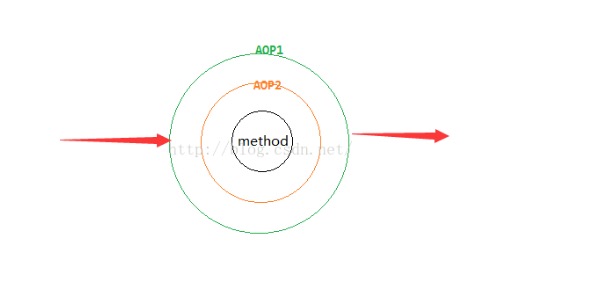- 1Stable Diffusion基础:ControlNet之人体姿势控制_为什么我的controlnet不能控制骨架
- 2在VSCode中配置Verilog语言环境并使用学习WaveTrace插件
- 3GitHub配置SSH Key(详细版本)_github ssh key配置
- 4OpenCV项目开发实战--条形码和 QR 码扫描器(C++ 和 Python)的代码实现_opencv二维码检测c++
- 5六、Redis 分布式系统 —— 超详细操作演示!_redis怎么实现分布式
- 6解决 springboot项目打包部署到linux系统下,下载resources/static/静态资源找不到的问题_spirngboot 静态资源,打包到linux 丢失
- 7Linux文件权限_linux 文件权限
- 8vscode连接 gitee_vscode 使用ssh连接gitee
- 9图论(二):图的四种最短路径算法
- 10anaconda实现python环境搭建_anaconda配置python环境
spring aop详解
赞
踩
1.前言
spring aop是一个面向切面的编程,在自己第一遍学习的时候,感觉aop没有什么作用,但是真实接触下来,感觉spring aop还是很有用途的,感觉自己之前的想法太年轻了。
2.概念
Spring 提供了两种AOP 的实现:基于注解式配置和基于XML配置,我这里主要就是介绍一下,基于注解式配置。
2.1 AOP 即 Aspect Oriented Program 面向切面编程
首先,在面向切面编程的思想里面,把功能分为核心业务功能,和周边功能。
-
所谓的核心业务,工作中做的最多的就是增删改查,增删改查都叫核心业务。
-
所谓的周边功能,比如性能统计,日志记录,事务管理等等
周边功能在 Spring 的面向切面编程AOP思想里,即被定义为切面
在面向切面编程AOP的思想里面,核心业务功能和切面功能分别独立进行开发,然后把切面功能和核心业务功能 "编织" 在一起,这就叫AOP
2.2 AOP 的目的
AOP能够将那些与业务无关,却为业务模块所共同调用的逻辑或责任(例如事务处理、日志管理、权限控制等)封装起来,便于减少系统的重复代码,降低模块间的耦合度,并有利于未来的可拓展性和可维护性。
2.3 AOP 当中的概念:
-
切面 (Aspect)可以理解成,就是一个特殊的类(包含的都是增强核心业务的代码),切面 = 切入点 + 通知,通俗点就是:在什么时机,什么地方,做什么增强!
-
连接点(join point)通俗理解就是整个系统的所有方法都可以称为连接点
-
切入点(Pointcut) 就是被选中的连接点,可以通过execution来确定选中的连接点有哪些
-
通知(Advice)在方法执行的什么实际(when:方法前/方法后/方法前后)做什么(what:增强的功能),就是切面这个类中的代码块
-
织入(Weaving) 把切面加入到对象,并创建出代理对象的过程。(由 Spring 来完成)
2.4 Spring Aop中的通知类型:
-
前置通知(Before Advice): 在目标方法被调用前调用通知功能;相关的类
org.springframework.aop.MethodBeforeAdvice -
后置通知(After Advice): 在目标方法被调用之后调用通知功能;相关的类
org.springframework.aop.AfterReturningAdvice -
返回通知(After-returning): 在目标方法成功执行之后调用通知功能;
-
异常通知(After-throwing): 在目标方法抛出异常之后调用通知功能;相关的类
org.springframework.aop.ThrowsAdvice -
环绕通知(Around): 把整个目标方法包裹起来,在被调用前和调用之后分别调用通知功能相关的类
org.aopalliance.intercept.MethodInterceptor
2.5 spring Aop实现的基础
spring aop实现是通过动态代理的方式实现的,动态代理避免了静态代理需要定义冗余的代理类,实现类,动态代理分为两种,第一种就是jdk 动态代理,第二种就是cglib 动态代理,aop 实现同时采用两种代理模式。
两种动态代理的区别:
jdk动态代理模式 :采用反射的方式,只能对实现接口的类生成代理,具有加载速度快,执行效率低的特点。
cglib动态代理模式:采用的asm,通过字节码形式实现,是针对类实现代理,具有加载速度慢,执行效率高的特点。
2.6 基于AspectJ实现基础上需要连接的几个内置注解
execution函数用于匹配方法执行的连接点,语法为:
execution(方法修饰符(可选) 返回类型 方法名(参数) 异常模式(可选))
参数部分允许使用通配符:
* 匹配任意字符,但只能匹配一个元素
.. 匹配任意字符,可以匹配任意多个元素(零到若干个都可以),必须和*联合使用
"execution(public * com.qli.controller.TestController.*(..))"
@Pointcut(value = "@annotation(com.qli.config.RequestLog)")任何方法使用RequestLog注解都会触发该切面,进入切点
3.实现
具体的案例,在spring boot中实现spring aop,包含的内容有通过aop实现自定义注解,听起来就很高大上,其实懂了之后,感觉就那样,不过在新入门的程序员面前还是可以装起来的,还有就是多个切面的时候的执行顺序
3.1导入依赖
<!--引入父依赖 当前工程 继承 父类工程 spring-boot-starter-parent pom --> <parent> <groupId>org.springframework.boot</groupId> <artifactId>spring-boot-starter-parent</artifactId> <version>2.1.3.RELEASE</version> <relativePath/> </parent> <properties> <project.build.sourceEncoding>UTF-8</project.build.sourceEncoding> <project.reporting.outputEncoding>UTF-8</project.reporting.outputEncoding> <java.version>1.8</java.version> </properties> <dependencies> <!-- web相关依赖--> <dependency> <groupId>org.springframework.boot</groupId> <artifactId>spring-boot-starter-web</artifactId> </dependency> <dependency> <groupId>org.springframework.boot</groupId> <artifactId>spring-boot-starter-test</artifactId> </dependency> <dependency> <groupId>org.springframework.boot</groupId> <artifactId>spring-boot-starter-aop</artifactId> </dependency> </dependencies>
3.2创建切面
package com.qli.config;
import org.aspectj.lang.JoinPoint;
import org.aspectj.lang.ProceedingJoinPoint;
import org.aspectj.lang.annotation.*;
import org.springframework.core.annotation.Order;
import org.springframework.stereotype.Component;
import org.springframework.web.context.request.RequestContextHolder;
import org.springframework.web.context.request.ServletRequestAttributes;
import javax.servlet.http.HttpServletRequest;
import java.util.Arrays;
@Aspect
@Component
@Order(2)
public class LogAspect {
@Pointcut("execution(public * com.qli.controller.TestController.*(..))")
public void webLog(){}
@Before("webLog()")
public void deBefore(JoinPoint joinPoint) throws Throwable {
// 接收到请求,记录请求内容
ServletRequestAttributes attributes = (ServletRequestAttributes) RequestContextHolder.getRequestAttributes();
HttpServletRequest request = attributes.getRequest();
// 记录下请求内容
System.out.println("URL : " + request.getRequestURL().toString());
System.out.println("HTTP_METHOD : " + request.getMethod());
System.out.println("IP : " + request.getRemoteAddr());
System.out.println("CLASS_METHOD : " + joinPoint.getSignature().getDeclaringTypeName() + "." + joinPoint.getSignature().getName());
System.out.println("ARGS : " + Arrays.toString(joinPoint.getArgs()));
}
@AfterReturning(returning = "ret", pointcut = "webLog()")
public void doAfterReturning(Object ret) throws Throwable {
// 处理完请求,返回内容
System.out.println("方法的返回值 : " + ret);
}
//后置异常通知
@AfterThrowing("webLog()")
public void throwss(JoinPoint jp){
System.out.println("方法异常时执行.....");
}
//后置最终通知,final增强,不管是抛出异常或者正常退出都会执行
@After("webLog()")
public void after(JoinPoint jp){
System.out.println("方法最后执行.....");
}
//环绕通知,环绕增强,相当于MethodInterceptor
@Around("webLog()")
public Object arround(ProceedingJoinPoint pjp) {
System.out.println("方法环绕start.....");
try {
Object o = pjp.proceed();
System.out.println("方法环绕proceed,结果是 :" + o);
return o;
} catch (Throwable e) {
e.printStackTrace();
return null;
}
}
}
3.3 创建控制类
package com.qli.controller;
import com.qli.config.RequestLog;
import org.springframework.web.bind.annotation.RequestMapping;
import org.springframework.web.bind.annotation.RestController;
@RestController
public class TestController {
@RequestMapping("/requestLog")
public String requestLog(){
return "first controller";
}
}
执行结果:
方法环绕start..... URL : http://localhost:8088/requestLog HTTP_METHOD : GET IP : 0:0:0:0:0:0:0:1 CLASS_METHOD : com.qli.controller.TestController.requestLog ARGS : [] 方法环绕proceed,结果是 :first controller 方法最后执行..... 方法的返回值 : first controller
上边是创建一个切面通过 @Pointcut("execution(public * com.qli.controller.TestController.*(..))")注解来限制切入点是controller包下TestController控制类下所有的方法都是切入点,那么congtroller包下其他控制类的方法就是连接点。
3.4创建自定义注解
3.4.1自定义注解之前需要了解的概念
-
@Target注解,是专门用来限定某个自定义注解能够被应用在哪些Java元素上面的。它使用一个枚举类型定义如下:
public enum ElementType { /** 类,接口(包括注解类型)或枚举的声明 */ TYPE, /** 属性的声明 */ FIELD, /** 方法的声明 */ METHOD, /** 方法形式参数声明 */ PARAMETER, /** 构造方法的声明 */ CONSTRUCTOR, /** 局部变量声明 */ LOCAL_VARIABLE, /** 注解类型声明 */ ANNOTATION_TYPE, /** 包的声明 */ PACKAGE } -
@Retention注解,翻译为持久力、保持力。即用来修饰自定义注解的生命力。
public enum RetentionPolicy { /** * Annotations are to be discarded by the compiler. * (注解将被编译器忽略掉) */ SOURCE, /** * Annotations are to be recorded in the class file by the compiler * but need not be retained by the VM at run time. This is the default * behavior. * (注解将被编译器记录在class文件中,但在运行时不会被虚拟机保留,这是一个默认的行为) */ CLASS, /** * Annotations are to be recorded in the class file by the compiler and * retained by the VM at run time, so they may be read reflectively. * (注解将被编译器记录在class文件中,而且在运行时会被虚拟机保留,因此它们能通过反射被读取到) * @see java.lang.reflect.AnnotatedElement */ RUNTIME } -
@Documented注解,是被用来指定自定义注解是否能随着被定义的java文件生成到JavaDoc文档当中。
3.5 实现
3.5.1 创建自定义注解
@Retention(RetentionPolicy.RUNTIME)
@Target(ElementType.METHOD)
@Documented
public @interface RequestLog {
String desc() default "无信息";
}
3.5.2 创建自定义注解时候后将会触发的切面
package com.qli.config;
import org.aspectj.lang.JoinPoint;
import org.aspectj.lang.ProceedingJoinPoint;
import org.aspectj.lang.annotation.Around;
import org.aspectj.lang.annotation.Aspect;
import org.aspectj.lang.annotation.Before;
import org.aspectj.lang.annotation.Pointcut;
import org.springframework.core.annotation.Order;
import org.springframework.stereotype.Component;
@Component
@Aspect
@Order(1)
public class RequestAspect {
@Pointcut(value = "@annotation(com.qli.config.RequestLog)")
public void access() {
}
@Before("access()")
public void deBefore(JoinPoint joinPoint) throws Throwable {
System.out.println("second before");
}
@Around("@annotation(requestLog)")
public Object around(ProceedingJoinPoint pjp, RequestLog requestLog) {
//获取注解里的值
System.out.println("second around:" + requestLog.desc());
try {
return pjp.proceed();
} catch (Throwable throwable) {
throwable.printStackTrace();
return null;
}
}
}
3.5.3 在控制层添加
@RequestLog(desc = "second")
@RequestMapping("/second")
public Object second(){
return "second controller";
}
执行结果
second around:second second before
如果将两个切面的切入点都包含有second这个方法的时候,浏览器访问http://localhost:8088/second的执行结果如下
second around:second second before 方法环绕start..... URL : http://localhost:8088/second HTTP_METHOD : GET IP : 0:0:0:0:0:0:0:1 CLASS_METHOD : com.qli.controller.TestController.second ARGS : [] 方法环绕proceed,结果是 :second controller 方法最后执行..... 方法的返回值 : second controller
执行顺序:
spring aop就是一个同心圆,要执行的方法为圆心,最外层的order最小。从最外层按照AOP1、AOP2的顺序依次执行doAround方法,doBefore方法。然后执行method方法,最后按照AOP2、AOP1的顺序依次执行doAfter、doAfterReturn方法。也就是说对多个AOP来说,先before的,一定后after。



